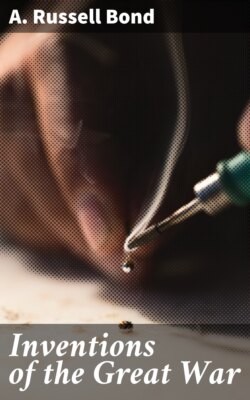Читать книгу Inventions of the Great War - A. Russell Bond - Страница 8
На сайте Литреса книга снята с продажи.
PERISCOPES AND "SNIPERSCOPES"
ОглавлениеTable of Contents
But while the armies were buried underground, it was necessary for them to keep their eyes upon each other so that each might be ready for any sudden onslaught of the other. Snipers were always ready to fire at any head that showed itself above the parapet of the trench and so the soldiers had to steal an idea from the submarines and build them periscopes with which they could look over the top of their trenches without exposing themselves. A trench periscope was a very simple affair, consisting of a tube with two mirrors, one at the top and one at the bottom, set at such an angle that a person looking into the side of the tube at the bottom could see out of the opposite side of the tube at the top.
Observation posts were established wherever there was a slight rise in the ground. Sometimes these posts were placed far in advance of the trenches and sometimes even behind the trenches where it was possible to obtain a good view of the opposing lines. Sometimes a tunnel would be dug forward, leading to an outlet close to the enemy's lines, and here an observer would take his position at night to spy with his ears upon the activities of the enemy. Observers who watched the enemy by day would often not dare to use periscopes, which might be seen by the enemy and draw a concentrated fire of rifles and even shell. So that every manner of concealment was employed to make the observation posts invisible and to have them blend with their surroundings. Observers even wore veils so that the white of their skin would not betray them.
Redrawn from Military Map Reading by permission of E. C. McKay
Fig 1. A "sniperscope" with which a sharpshooter could take aim without showing his head above the parapet
Snipers were equally ingenious in concealing themselves. They frequently used rifles which were connected with a dummy butt and had a periscope sighting-attachment. This attachment was called a "sniperscope." The rifle-barrel could be pushed through a loophole in the parapet and the sniper standing safely below the parapet could hold the dummy butt to his shoulder and aim his rifle with perfect accuracy by means of the periscope. It was next to impossible to locate a sniper hidden in this way. One method of doing it was to examine rubbish, tin cans, or any object that had been penetrated by a bullet and note the direction taken by the bullet. This would give a line leading toward the source of the shot, and when a number of such lines were traced, they would cross at a spot where the sniper or his gun was stationed, and a few shell would put the man out of business. Dummy heads of papier mâché were sometimes stuck above the parapet to draw the fire of enemy snipers and the bullet-holes which quickly appeared in them were studied to discover the location of the snipers.
